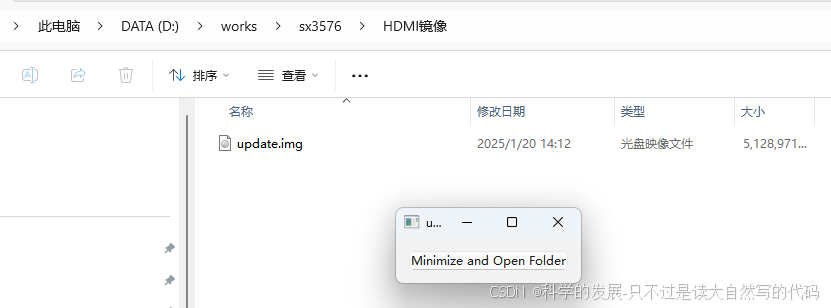1.概要
2.内容
需求说明:ubuntu系统,qt 点击一个按钮,然后将当前的窗口最小化。然后调用系统的文件夹打开功能,打开一个文件夹
在 Ubuntu 系统上使用 Qt 开发应用程序时,如果你希望在点击一个按钮时将当前窗口最小化,并调用系统的文件管理器来打开一个文件夹,你可以使用以下步骤实现。
实现思路
- 最小化窗口:使用
QWidget::showMinimized()方法将窗口最小化。 - 打开系统文件夹:使用
QDesktopServices::openUrl()配合QUrl::fromLocalFile()来调用系统文件管理器打开指定文件夹。
示例代码
下面是一个完整的 Qt 示例程序,展示了如何实现上述功能:
#ifndef MYWIDGET_H
#define MYWIDGET_H
#include <QPushButton>
#include <QVBoxLayout>
#include <QWidget>
#include <QDesktopServices>
#include <QUrl>
class MyWidget : public QWidget {
Q_OBJECT
public:
MyWidget(QWidget *parent = nullptr) : QWidget(parent) {
QVBoxLayout *layout = new QVBoxLayout(this);
QPushButton *button = new QPushButton("Minimize and Open Folder", this);
layout->addWidget(button);
connect(button, &QPushButton::clicked, this, &MyWidget::minimizeAndOpenFolder);
setLayout(layout);
}
private slots:
void minimizeAndOpenFolder() {
// Minimize the window
showMinimized();
// Open a specific folder using the system file manager
QString folderPath = "D:\\works\\sx3576\\HDMI镜像"; // Replace with your desired path
QUrl url = QUrl::fromLocalFile(folderPath);
QDesktopServices::openUrl(url);
}
};
#endif // MYWIDGET_H
#include <QApplication>
#include "MyWidget.h"
int main(int argc, char *argv[]) {
QApplication app(argc, argv);
MyWidget w;
w.show();
return app.exec();
}
运行效果
代码说明
- MyWidget 类:
- 继承自
QWidget。 - 在构造函数中创建一个按钮,并将其添加到布局中。
- 使用
connect函数将按钮的clicked信号连接到minimizeAndOpenFolder槽函数。
- 继承自
- minimizeAndOpenFolder 槽函数:
- 调用
showMinimized()将窗口最小化。 - 使用
QUrl::fromLocalFile()创建一个指向目标文件夹的QUrl对象。 - 使用
QDesktopServices::openUrl()打开该 URL,这会调用系统的文件管理器来打开指定的文件夹。
- 调用
- main 函数:
- 创建
QApplication对象。 - 创建并显示
MyWidget窗口。 - 进入应用程序的事件循环。
- 创建
注意事项
- 路径设置:确保
folderPath变量设置为你要打开的实际文件夹路径。 - 权限:确保应用程序有权限访问和打开指定的文件夹。
- 系统依赖:
QDesktopServices::openUrl()依赖于系统的默认文件管理器,因此确保系统上安装并配置了默认的文件管理器。
编译并运行这个程序,点击按钮时,窗口将会最小化,并且系统会打开指定的文件夹。
3.关联链接
4.关联知识
1.QDesktopServices::openUrl(url);
QDesktopServices::openUrl() 是 Qt 提供的一个静态函数,用于在默认浏览器中打开 URL,或者用于打开文件或文件夹(取决于 URL 的类型)。当你提供一个指向本地文件或文件夹的 QUrl 时,它通常会调用系统的文件管理器来打开该位置。
使用 QDesktopServices::openUrl() 打开文件夹
要打开一个文件夹,你需要创建一个指向该文件夹路径的 QUrl,然后调用 QDesktopServices::openUrl()。以下是一个具体的例子,展示如何使用这个函数来打开一个本地文件夹:
#include <QApplication>
#include <QPushButton>
#include <QVBoxLayout>
#include <QWidget>
#include <QDesktopServices>
#include <QUrl>
class MyWidget : public QWidget {
Q_OBJECT
public:
MyWidget(QWidget *parent = nullptr) : QWidget(parent) {
QVBoxLayout *layout = new QVBoxLayout(this);
QPushButton *button = new QPushButton("Minimize and Open Folder", this);
layout->addWidget(button);
connect(button, &QPushButton::clicked, this, &MyWidget::minimizeAndOpenFolder);
setLayout(layout);
}
private slots:
void minimizeAndOpenFolder() {
// Minimize the window
showMinimized();
// Open a specific folder using the system file manager
QString folderPath = "/home/your-username/Documents"; // Replace with your desired path
QUrl url = QUrl::fromLocalFile(folderPath);
bool success = QDesktopServices::openUrl(url);
if (!success) {
qWarning("Failed to open the folder.");
}
}
};
int main(int argc, char *argv[]) {
QApplication app(argc, argv);
MyWidget w;
w.show();
return app.exec();
}
#include "main.moc" // Include this if you are using a single file for both code and MOC
代码说明
- QUrl::fromLocalFile():
- 将本地文件路径转换为
QUrl对象。这个 URL 可以被QDesktopServices::openUrl()使用来打开文件或文件夹。
- 将本地文件路径转换为
- QDesktopServices::openUrl():
- 接受一个
QUrl对象作为参数。 - 在大多数情况下,如果 URL 指向一个本地文件夹,系统会调用默认的文件管理器来打开该文件夹。
- 返回一个布尔值,指示操作是否成功。如果返回
false,可能意味着无法打开文件夹(例如,路径不存在或没有权限)。
- 接受一个
- 错误处理:
- 可以通过检查
openUrl()的返回值来确定操作是否成功。如果不成功,可以使用qWarning()或其他日志机制来记录错误信息。
- 可以通过检查
注意事项
- 路径有效性:确保
folderPath是一个有效的路径,并且应用程序有权限访问该路径。 - 系统依赖:此功能依赖于系统的默认文件管理器,因此确保目标系统上已安装并配置了文件管理器。
- 跨平台性:虽然
QDesktopServices::openUrl()在大多数平台上都能正常工作,但具体的行为可能会因操作系统的不同而有所差异。
通过这种方式,你可以在 Qt 应用程序中实现点击按钮后最小化窗口并打开指定文件夹的功能。
2.qt 点击一个按钮,打开一个文件夹
在 Qt 中,要实现点击一个按钮打开一个文件夹,可以使用 QFileDialog 类。以下是一个简单的示例,展示如何创建一个包含按钮的窗口,当点击该按钮时,会打开一个文件夹选择对话框。
首先,确保你已经安装了 Qt 库,并设置好了 Qt 开发环境。
下面是一个完整的示例代码:
#include <QApplication>
#include <QPushButton>
#include <QFileDialog>
#include <QVBoxLayout>
#include <QWidget>
class MyWidget : public QWidget {
Q_OBJECT
public:
MyWidget(QWidget *parent = nullptr) : QWidget(parent) {
QVBoxLayout *layout = new QVBoxLayout(this);
QPushButton *button = new QPushButton("Open Folder", this);
layout->addWidget(button);
connect(button, &QPushButton::clicked, this, &MyWidget::openFolder);
setLayout(layout);
}
private slots:
void openFolder() {
QString directory = QFileDialog::getExistingDirectory(this, tr("Open Directory"),
"", QFileDialog::ShowDirsOnly | QFileDialog::DontResolveSymlinks);
if (!directory.isEmpty()) {
// Handle the selected directory, e.g., display it or store it
qDebug() << "Selected directory:" << directory;
}
}
};
int main(int argc, char *argv[]) {
QApplication app(argc, argv);
MyWidget w;
w.show();
return app.exec();
}
#include "main.moc" // Include this if you are using a single file for both code and MOC
代码说明:
- 包含头文件:
#include <QApplication>:Qt 应用程序类。#include <QPushButton>:Qt 按钮类。#include <QFileDialog>:Qt 文件对话框类。#include <QVBoxLayout>:垂直布局管理器。#include <QWidget>:所有用户界面对象的基类。
- 定义
MyWidget类:- 继承自
QWidget。 - 构造函数中创建一个垂直布局和一个按钮,将按钮添加到布局中。
- 使用
connect函数将按钮的clicked信号连接到openFolder槽函数。
- 继承自
- 实现
openFolder槽函数:- 使用
QFileDialog::getExistingDirectory打开文件夹选择对话框。 - 如果选择了文件夹,可以处理选择的文件夹路径,例如在这里使用
qDebug()输出路径。
- 使用
main函数:- 创建
QApplication对象。 - 创建并显示
MyWidget窗口。 - 进入应用程序的事件循环。
- 创建
注意事项:
-
如果你将代码放在一个单独的文件中,并且使用
Q_OBJECT宏,你可能需要运行qmake或使用 Qt Creator 来自动生成 MOC 文件。上面的代码示例中包含#include "main.moc",这在单文件项目中是常见的做法。如果你使用多文件项目,通常会将 MOC 文件的生成交给构建系统处理。 -
QFileDialog::getExistingDirectory的参数允许你定制对话框的行为,例如设置初始目录和选项。
编译并运行这个程序,点击按钮时将会打开一个文件夹选择对话框。
3.qt 点击一个按钮,关闭当前的窗口,然后打开一个文件夹
在 Qt 中,如果你想在点击一个按钮时关闭当前窗口并打开一个文件夹,你可以通过连接按钮的 clicked 信号到相应的槽函数来实现。在槽函数中,你可以调用 close() 方法来关闭窗口,然后使用 QFileDialog::getExistingDirectory 来打开文件夹选择对话框。
不过,需要注意的是,一旦窗口关闭,与该窗口相关的所有对象(包括槽函数所在的对象)通常也会被销毁。因此,如果你想在关闭窗口后仍然执行某些操作(比如打开文件夹),你可能需要在窗口关闭之前或在另一个持久存在的对象中执行这些操作。
一种解决方案是在关闭窗口之前打开文件夹。以下是一个示例代码:
#include <QApplication>
#include <QPushButton>
#include <QFileDialog>
#include <QVBoxLayout>
#include <QWidget>
#include <QDebug>
class MyWidget : public QWidget {
Q_OBJECT
public:
MyWidget(QWidget *parent = nullptr) : QWidget(parent) {
QVBoxLayout *layout = new QVBoxLayout(this);
QPushButton *button = new QPushButton("Close and Open Folder", this);
layout->addWidget(button);
connect(button, &QPushButton::clicked, this, &MyWidget::closeAndOpenFolder);
setLayout(layout);
}
private slots:
void closeAndOpenFolder() {
// Open the folder first
QString directory = QFileDialog::getExistingDirectory(this, tr("Open Directory"),
"", QFileDialog::ShowDirsOnly | QFileDialog::DontResolveSymlinks);
if (!directory.isEmpty()) {
qDebug() << "Selected directory:" << directory;
}
// Close the window after opening the folder
close();
}
};
int main(int argc, char *argv[]) {
QApplication app(argc, argv);
MyWidget w;
w.show();
return app.exec();
}
#include "main.moc" // Include this if you are using a single file for both code and MOC
代码说明:
- MyWidget 类:
- 继承自
QWidget。 - 在构造函数中创建一个按钮,并将其添加到布局中。
- 使用
connect函数将按钮的clicked信号连接到closeAndOpenFolder槽函数。
- 继承自
- closeAndOpenFolder 槽函数:
- 首先使用
QFileDialog::getExistingDirectory打开文件夹选择对话框。 - 如果选择了文件夹,可以处理选择的文件夹路径,例如在这里使用
qDebug()输出路径。 - 然后调用
close()方法关闭窗口。
- 首先使用
- main 函数:
- 创建
QApplication对象。 - 创建并显示
MyWidget窗口。 - 进入应用程序的事件循环。
- 创建
注意事项:
- 由于窗口在打开文件夹对话框后立即关闭,用户可能会看到窗口消失,而文件夹对话框仍然打开。这通常是预期的行为,因为你希望在关闭窗口之前执行某些操作。
- 如果你需要在窗口关闭后继续执行一些与窗口无关的操作,你可能需要考虑将这些操作移到另一个对象中,该对象在窗口关闭后仍然存在。
编译并运行这个程序,点击按钮时将会先打开一个文件夹选择对话框,然后关闭当前窗口。























 1万+
1万+

 被折叠的 条评论
为什么被折叠?
被折叠的 条评论
为什么被折叠?








